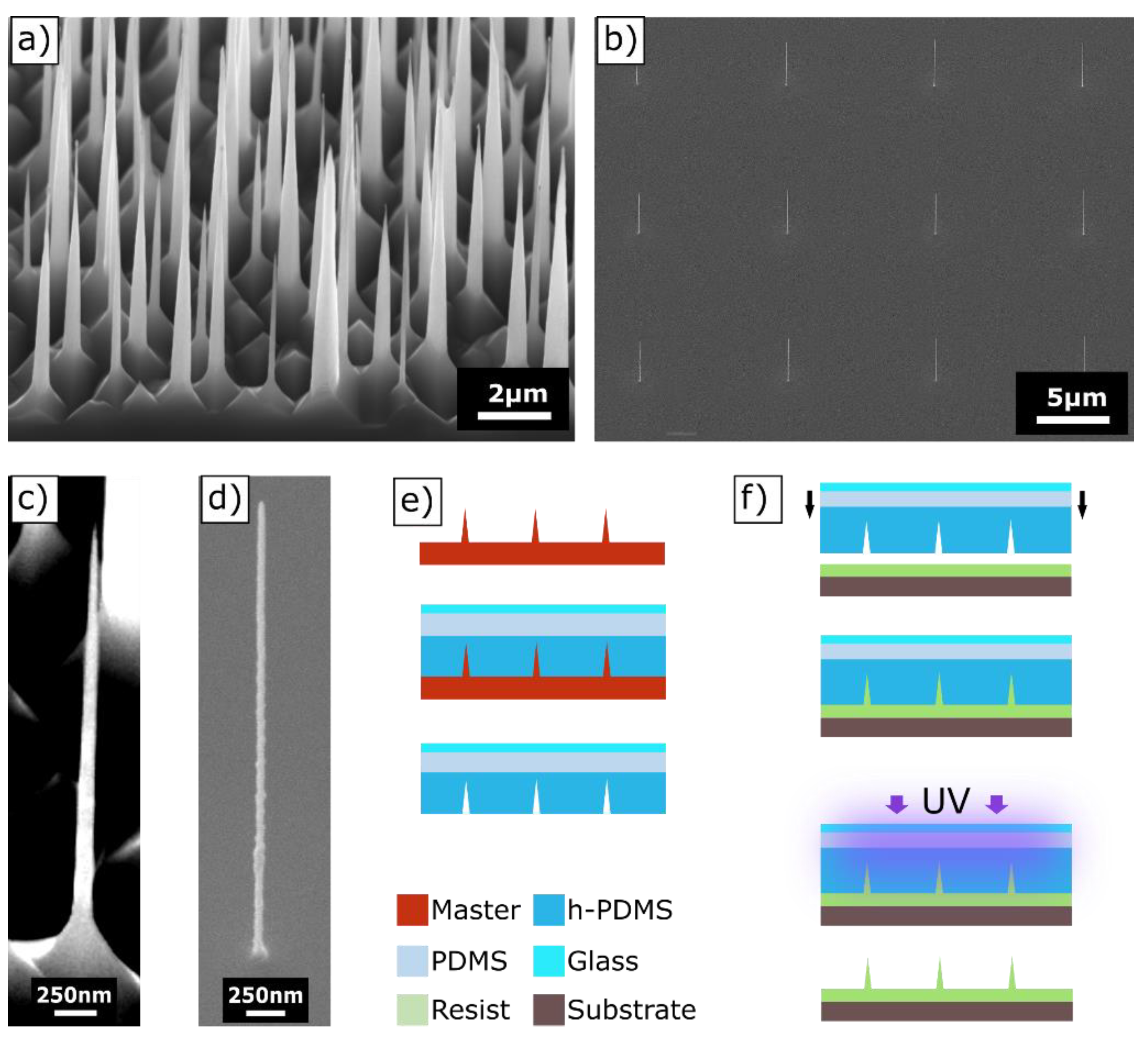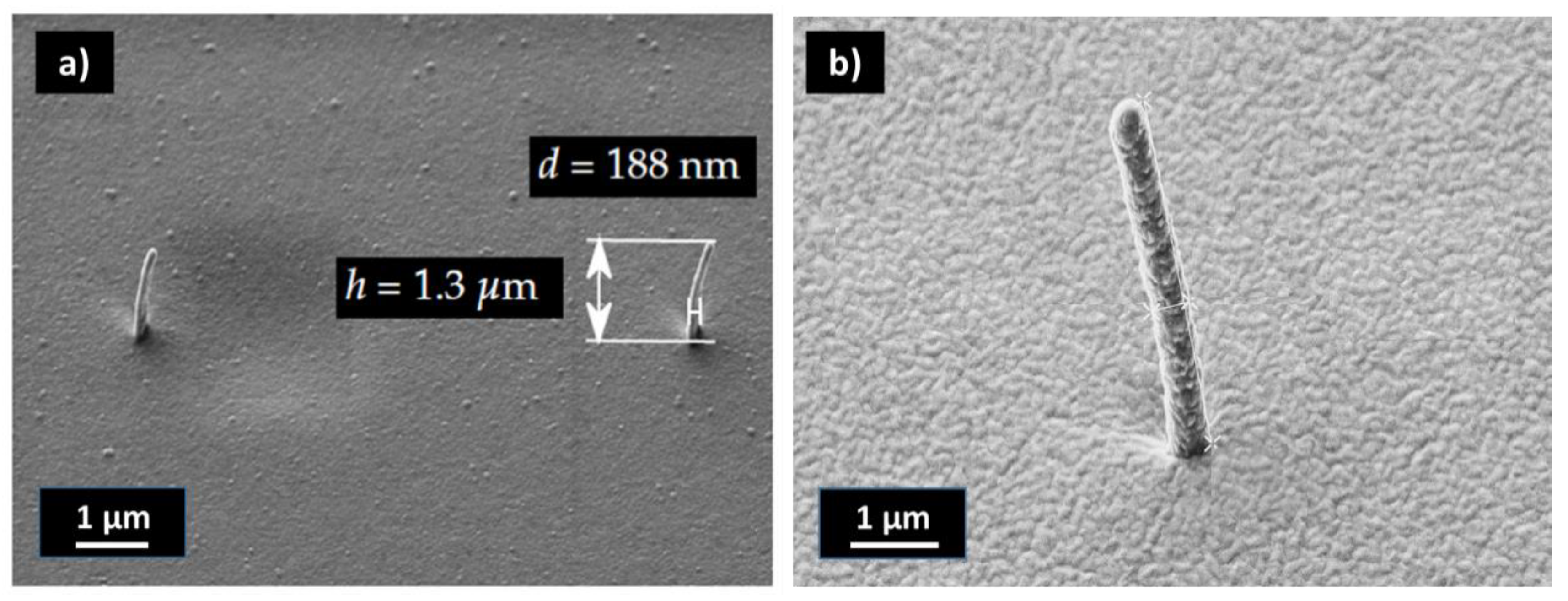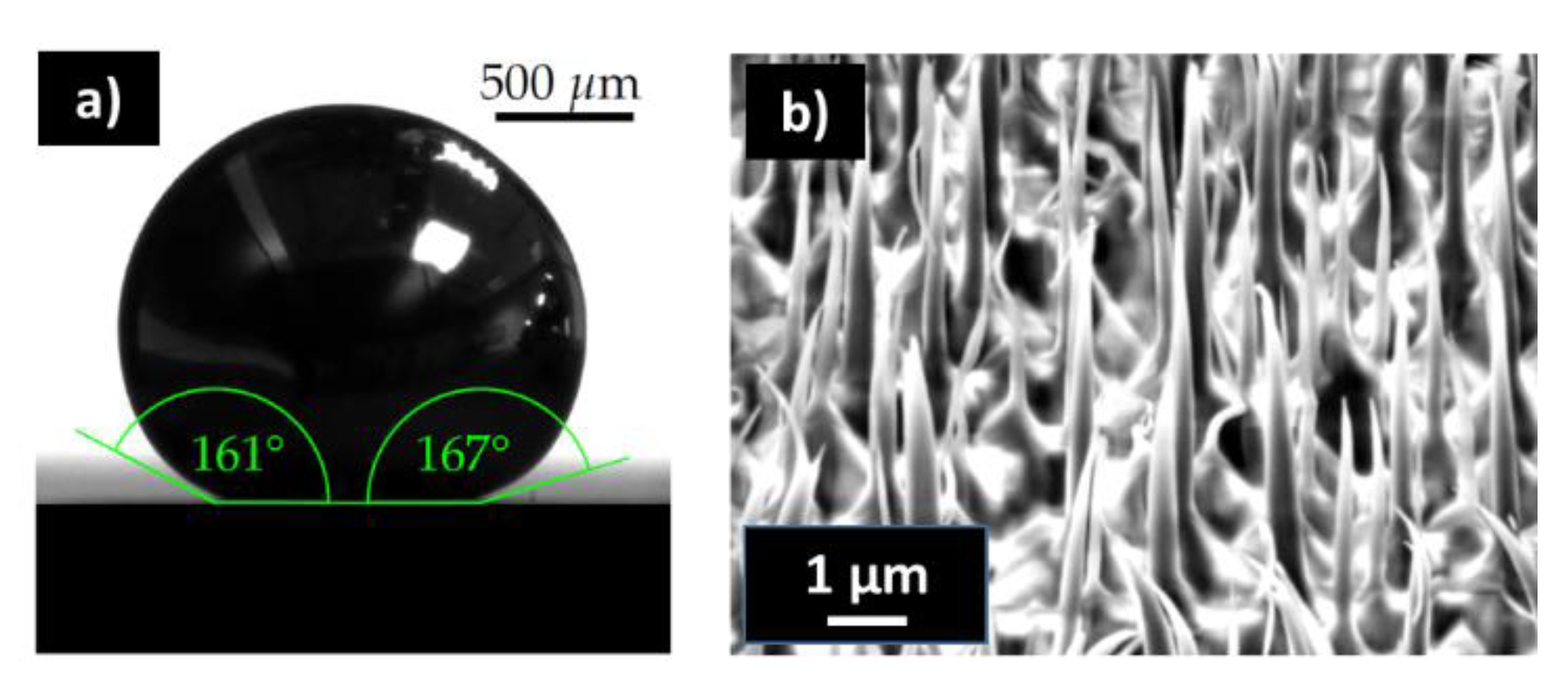Increasing the Stability of Isolated and Dense High-Aspect-Ratio Nanopillars Fabricated Using UV-Nanoimprint Lithography
Abstract
1. Introduction
2. Materials and Methods
2.1. Materials
2.2. Master Fabrication
2.3. Stamp Fabrication and UV-NIL Replication
2.4. Characterization
2.5. Post-Processing, Coating and Electrical Functionality
2.6. Simulations
3. Results and Discussion
3.1. Experimental Design
3.2. Stability Considerations and the Influence of Liquids on Dense Polymeric Nanostructures
3.3. Coating of Nanoimprinted Nanostructures
4. Conclusions
Supplementary Materials
Author Contributions
Funding
Data Availability Statement
Acknowledgments
Conflicts of Interest
References
- Kroisova, D. Microstructures and nanostructures in nature. In Progress in Optics; Elsevier: Amsterdam, The Netherlands, 2012; Volume 57, pp. 93–132. [Google Scholar]
- Muehlberger, M. Nanoimprinting of Biomimetic Nanostructures. Nanomanufacturing 2022, 2, 17–40. [Google Scholar] [CrossRef]
- Improved Broadband and Quasi-Omnidirectional Anti-Reflection Properties with Biomimetic Silicon Nanostructures|Nature Nanotechnology. Available online: https://www.nature.com/articles/nnano.2007.389 (accessed on 13 March 2023).
- Single-Imprint Moth-Eye Anti-Reflective and Self-Cleaning Film with Enhanced Resistance—Nanoscale (RSC Publishing). Available online: https://pubs.rsc.org/en/content/articlelanding/2018/NR/C8NR02386G (accessed on 13 March 2023).
- Ivanova, E.P.; Hasan, J.; Webb, H.K.; Gervinskas, G.; Juodkazis, S.; Truong, V.K.; Wu, A.H.F.; Lamb, R.N.; Baulin, V.A.; Watson, G.S.; et al. Bactericidal activity of black silicon. Nat. Commun. 2013, 4, 2838. [Google Scholar] [CrossRef] [PubMed]
- Modaresifar, K.; Azizian, S.; Ganjian, M.; Fratila-Apachitei, L.E.; Zadpoor, A.A. Bactericidal effects of nanopatterns: A systematic review. Acta Biomater. 2019, 83, 29–36. [Google Scholar] [CrossRef]
- Li, Y.; Zhang, J.; Zhu, S.; Dong, H.; Wang, Z.; Sun, Z.; Guo, J.; Yang, B. Bioinspired silicon hollow-tip arrays for high performance broadband anti-reflective and water-repellent coatings. J. Mater. Chem. 2009, 19, 1806–1810. [Google Scholar] [CrossRef]
- Haslinger, M.J.; Moharana, A.R.; Mühlberger, M. Antireflective moth-eye structures on curved surfaces fabricated by nanoimprint lithography. In Proceedings of the 35th European Mask and Lithography Conference (EMLC 2019), Dresden, Germany, 17–19 June 2019; Volume 11177, p. 111770K. [Google Scholar] [CrossRef]
- Pribyl, M.; Taus, P.; Prado-López, S.; Dozio, S.M.; Schrenk, W.; Haslinger, M.J.; Kopp, S.; Mühlberger, M.; Wanzenboeck, H.D. Dense high aspect ratio nanostructures for cell chip applications-Fabrication, replication, and cell interactions. Micro Nano Eng. 2022, 15, 100121. [Google Scholar] [CrossRef]
- Seong, H.; Higgins, S.G.; Penders, J.; Armstrong, J.P.; Crowder, S.W.; Moore, A.C.; Sero, J.E.; Becce, M.; Stevens, M.M. Size-tunable nanoneedle arrays for influencing stem cell morphology, gene expression, and nuclear membrane curvature. ACS Nano 2020, 14, 5371–5381. [Google Scholar] [CrossRef] [PubMed]
- Jäggi, R.D.; Sandoz, R.; Effenhauser, C.S. Microfluidic depletion of red blood cells from whole blood in high-aspect-ratio microchannels. Microfluid. Nanofluidics 2007, 3, 47–53. [Google Scholar] [CrossRef]
- Chandna, P.; Gundabala, V. Pillar based microfluidic approach to sorting of microparticle mixtures at various particle ratios. Microfluid. Nanofluidics 2021, 25, 6. [Google Scholar] [CrossRef]
- Krieger, K.J.; Bertollo, N.; Dangol, M.; Sheridan, J.T.; Lowery, M.M.; O’Cearbhaill, E.D. Simple and customizable method for fabrication of high-aspect ratio microneedle molds using low-cost 3D printing. Microsyst. Nanoeng. 2019, 5, 42. [Google Scholar] [CrossRef]
- Antonov, P.V.; Zuiddam, M.R.; Frenken, J.W. Fabrication of high-aspect ratio silicon nanopillars for tribological experiments. J. MicroNanolithogr. MEMS MOEMS 2015, 14, 044506. [Google Scholar] [CrossRef]
- Hong, H.; Kim, Y.J.; Han, M.; Yoo, G.; Song, H.W.; Chae, Y.; Pyun, J.-C.; Grossman, A.R.; Ryu, W. Prolonged and highly efficient intracellular extraction of photosynthetic electrons from single algal cells by optimized nanoelectrode insertion. Nano Res. 2018, 11, 397–409. [Google Scholar] [CrossRef]
- Hanein, Y.; Schabmueller, C.G.J.; Holman, G.; Luecke, P.; Denton, D.D.; Böhringer, K.F. High-aspect ratio submicrometer needles for intracellular applications. J. Micromech. Microeng. 2003, 13, S91. [Google Scholar] [CrossRef]
- Kubota, Y.; Oi, H.; Sawahata, H.; Goryu, A.; Ando, Y.; Numano, R.; Ishida, M.; Kawano, T. Nanoscale-Tipped High-Aspect-Ratio Vertical Microneedle Electrodes for Intracellular Recordings. Small 2016, 12, 2846–2853. [Google Scholar] [CrossRef] [PubMed]
- Arrigan, D.W. Nanoelectrodes, nanoelectrode arrays and their applications. Analyst 2004, 129, 1157–1165. [Google Scholar] [CrossRef] [PubMed]
- Li, X. Metal assisted chemical etching for high aspect ratio nanostructures: A review of characteristics and applications in photovoltaics. Curr. Opin. Solid State Mater. Sci. 2012, 16, 71–81. [Google Scholar] [CrossRef]
- Yamada, K.; Yamada, M.; Maki, H.; Itoh, K.M. Fabrication of arrays of tapered silicon micro-/nano-pillars by metal-assisted chemical etching and anisotropic wet etching. Nanotechnology 2018, 29, 28LT01. [Google Scholar] [CrossRef]
- Nakhoul, A.; Rudenko, A.; Maurice, C.; Reynaud, S.; Garrelie, F.; Pigeon, F.; Colombier, J.-P. Boosted Spontaneous Formation of High-Aspect Ratio Nanopeaks on Ultrafast Laser-Irradiated Ni Surface. Adv. Sci. 2022, 9, 2200761. [Google Scholar] [CrossRef]
- Utke, I.; Hoffmann, P.; Melngailis, J. Gas-assisted focused electron beam and ion beam processing and fabrication. J. Vac. Sci. Technol. B Microelectron. Nanometer Struct. Process. Meas. Phenom. 2008, 26, 1197–1276. [Google Scholar] [CrossRef]
- Fabrication of High-Aspect-Ratio Carbon Nanocone Probes by Electron Beam Induced Deposition Patterning|ETDEWEB. Available online: https://www.osti.gov/etdeweb/biblio/20832506 (accessed on 28 March 2023).
- Orús, P.; Sigloch, F.; Sangiao, S.; De Teresa, J.M. Superconducting W-C nanopillars fabricated by Ga+ focused ion beam induced deposition. J. Solid State Chem. 2022, 315, 123476. [Google Scholar] [CrossRef]
- LaFratta, C.N.; Baldacchini, T.; Farrer, R.A.; Fourkas, J.T.; Teich, M.C.; Saleh, B.E.; Naughton, M.J. Replication of two-photon-polymerized structures with extremely high aspect ratios and large overhangs. J. Phys. Chem. B 2004, 108, 11256–11258. [Google Scholar] [CrossRef]
- Chou, S.Y.; Krauss, P.R.; Renstrom, P.J. Nanoimprint lithography. J. Vac. Sci. Technol. B 1996, 14, 4129–4133. [Google Scholar] [CrossRef]
- Schift, H. Nanoimprint lithography: An old story in modern times? A review. J. Vac. Sci. Technol. B Microelectron. Nanometer Struct. 2008, 26, 458. [Google Scholar] [CrossRef]
- Morton, K.J.; Nieberg, G.; Bai, S.; Chou, S.Y. Wafer-scale patterning of sub-40 nm diameter and high aspect ratio ($\greater$50:1) silicon pillar arrays by nanoimprint and etching. Nanotechnology 2008, 19, 345301. [Google Scholar] [CrossRef]
- Haisma, J.; Verheijen, M.; van den Heuvel, K.; van den Berg, J. Mold-assisted nanolithography: A process for reliable pattern replication. J. Vac. Sci. Technol. B 1996, 14, 4124–4128. [Google Scholar] [CrossRef]
- Barcelo, S.; Li, Z. Nanoimprint lithography for nanodevice fabrication. Nano Converg. 2016, 3, 21. [Google Scholar] [CrossRef]
- Guo, L.J. Recent progress in nanoimprint technology and its applications. J. Phys. Appl. Phys. 2004, 37, R123–R141. [Google Scholar] [CrossRef]
- Oh, D.K.; Lee, T.; Ko, B.; Badloe, T.; Ok, J.G.; Rho, J. Nanoimprint lithography for high-throughput fabrication of metasurfaces. Front. Optoelectron. 2021, 14, 229–251. [Google Scholar] [CrossRef] [PubMed]
- Haslinger, M.J.; Mitteramskogler, T.; Kopp, S.; Leichtfried, H.; Messerschmidt, M.; Thesen, M.; Mühlberger, M. Development of a Soft UV-NIL Step&Repeat and Lift-Off Process Chain for High Speed Metal Nanomesh Fabrication. Nanotechnology 2020, 31, 345301. [Google Scholar] [CrossRef]
- Stormonth-Darling, J.M.; Pedersen, R.H.; How, C.; Gadegaard, N. Injection moulding of ultra high aspect ratio nanostructures using coated polymer tooling. J. Micromech. Microeng. 2014, 24, 075019. [Google Scholar] [CrossRef]
- Kuo, C.-W.; Shiu, J.-Y.; Chien, F.-C.; Tsai, S.-M.; Chueh, D.-Y.; Chen, P. Polymeric nanopillar arrays for cell traction force measurements. Electrophoresis 2010, 31, 3152–3158. [Google Scholar] [CrossRef]
- Aryal, M.; Buyukserin, F.; Mielczarek, K.; Zhao, X.-M.; Gao, J.; Zakhidov, A.; Hu, W. (Walter) Imprinted large-scale high density polymer nanopillars for organic solar cells. J. Vac. Sci. Technol. B Microelectron. Nanometer Struct. Process. Meas. Phenom. 2008, 26, 2562–2566. [Google Scholar] [CrossRef]
- Verschuuren, M.A.; Knight, M.W.; Megens, M.; Polman, A. Nanoscale spatial limitations of large-area substrate conformal imprint lithography. Nanotechnology 2019, 30, 345301. [Google Scholar] [CrossRef]
- Choi, M.K.; Yoon, H.; Lee, K.; Shin, K. Simple fabrication of asymmetric high-aspect-ratio polymer nanopillars by reusable AAO templates. Langmuir 2011, 27, 2132–2137. [Google Scholar] [CrossRef] [PubMed]
- Hirai, Y.; Yoshida, S.; Takagi, N.; Tanaka, Y.; Yabe, H.; Sasaki, K.; Sumitani, H.; Yamamoto, K. High Aspect Pattern Fabrication by Nano Imprint Lithography Using Fine Diamond Mold. Jpn. J. Appl. Phys. 2003, 42, 3863. [Google Scholar] [CrossRef]
- Bhadra, C.M.; Werner, M.; Baulin, V.A.; Truong, V.K.; Kobaisi, M.A.; Nguyen, S.H.; Balcytis, A.; Juodkazis, S.; Wang, J.Y.; Mainwaring, D.E.; et al. Subtle Variations in Surface Properties of Black Silicon Surfaces Influence the Degree of Bactericidal Efficiency. Nano-Micro Lett. 2018, 10, 36. [Google Scholar] [CrossRef] [PubMed]
- Chandra, D.; Yang, S. Stability of High-Aspect-Ratio Micropillar Arrays against Adhesive and Capillary Forces; ACS Publications: Washington, DC, USA, 2010; pp. 1080–1091. [Google Scholar]
- Li, M.; Chen, Y.; Luo, W.; Cheng, X. Interfacial Interactions during Demolding in Nanoimprint Lithography. Micromachines 2021, 12, 349. [Google Scholar] [CrossRef]
- Takai, R.; Yasuda, M.; Tochino, T.; Kawata, H.; Hirai, Y. Computational study of the demolding process in nanoimprint lithography. J. Vac. Sci. Technol. B Nanotechnol. Microelectron. Mater. Process. Meas. Phenom. 2014, 32, 06FG02. [Google Scholar] [CrossRef]
- Shiotsu, T.; Nishikura, N.; Yasuda, M.; Kawata, H.; Hirai, Y. Simulation study on the template release mechanism and damage estimation for various release methods in nanoimprint lithography. J. Vac. Sci. Technol. B 2013, 31, 06FB07. [Google Scholar] [CrossRef]
- Kim, I.; Mun, J.; Hwang, W.; Yang, Y.; Rho, J. Capillary-force-induced collapse lithography for controlled plasmonic nanogap structures. Microsyst. Nanoeng. 2020, 6, 65. [Google Scholar] [CrossRef]
- Wu, D.; Chen, Q.-D.; Xu, B.-B.; Jiao, J.; Xu, Y.; Xia, H.; Sun, H.-B. Self-organization of polymer nanoneedles into large-area ordered flowerlike arrays. Appl. Phys. Lett. 2009, 95, 091902. [Google Scholar] [CrossRef]
- Liu, X.; Wei, M.; Wang, Q.; Tian, Y.; Han, J.; Gu, H.; Ding, H.; Chen, Q.; Zhou, K.; Gu, Z. Capillary-Force-Driven Self-Assembly of 4D-Printed Microstructures. Adv. Mater. Deerfield Beach Fla 2021, 33, e2100332. [Google Scholar] [CrossRef]
- De Teresa, J.M. Nanofabrication: Nanolithography Techniques and Their Applications; IOP Publishing: Bristol, UK, 2020. [Google Scholar]
- Randolph, S.J.; Fowlkes, J.D.; Rack, P.D. Focused, nanoscale electron-beam-induced deposition and etching. Crit. Rev. Solid State Mater. Sci. 2006, 31, 55–89. [Google Scholar] [CrossRef]
- BGL-GZ-83|Profactor. Available online: https://www.profactor.at/en/solutions/coatings/ (accessed on 9 October 2017).
- Verschuuren, M.A. Substrate Conformal Imprint Lithography for Nanophotonics; Utrecht University: Utrecht, The Netherlands, 2010. [Google Scholar]
- Schmid, H.; Michel, B. Siloxane Polymers for High-Resolution, High-Accuracy Soft Lithography. Macromolecules 2000, 33, 3042–3049. [Google Scholar] [CrossRef]
- Schindelin, J.; Arganda-Carreras, I.; Frise, E.; Kaynig, V.; Longair, M.; Pietzsch, T.; Preibisch, S.; Rueden, C.; Saalfeld, S.; Schmid, B.; et al. Fiji: An open-source platform for biological-image analysis. Nat. Methods 2012, 9, 676–682. [Google Scholar] [CrossRef]
- Butler, D.L. Surface Roughness Measurement. In Encyclopedia of Microfluidics and Nanofluidics; Li, D., Ed.; Springer US: Boston, MA, USA, 2008; pp. 1945–1949. ISBN 978-0-387-32468-5. [Google Scholar]
- Maier, O.S. Fabrication of High Aspect-Ratio Polymeric Nanopillars by UV-Nanoimprint Lithography/Submitted by Oliver Stefan Maier. Master’s Thesis, University Linz, Linz, Austria, 2021. [Google Scholar]
- Tekniker|Research and Technology Centre. Available online: https://www.tekniker.es/en (accessed on 3 May 2021).
- Carthew, J.; Abdelmaksoud, H.H.; Hodgson-Garms, M.; Aslanoglou, S.; Ghavamian, S.; Elnathan, R.; Spatz, J.P.; Brugger, J.; Thissen, H.; Voelcker, N.H.; et al. Precision Surface Microtopography Regulates Cell Fate via Changes to Actomyosin Contractility and Nuclear Architecture. Adv. Sci. 2021, 8, 2003186. [Google Scholar] [CrossRef]
- Kidwell, D.A.; Lee, W.-K.; Perkins, K.; Gilpin, K.M.; O’Shaughnessy, T.J.; Robinson, J.T.; Sheehan, P.E.; Mulvaney, S.P. Chemistries for Making Additive Nanolithography in OrmoComp Permissive for Cell Adhesion and Growth. ACS Appl. Mater. Interfaces 2019, 11, 19793–19798. [Google Scholar] [CrossRef]
- Hardy, S.C. The surface tension of liquid gallium. J. Cryst. Growth 1985, 71, 602–606. [Google Scholar] [CrossRef]
- OrmoComp®|Micro Resist Technology GmbH. Available online: https://www.microresist.de/produkt/ormocomp/ (accessed on 9 October 2017).
- Neukirch, S.; Roman, B.; de Gaudemaris, B.; Bico, J. Piercing a liquid surface with an elastic rod: Buckling under capillary forces. J. Mech. Phys. Solids 2007, 55, 1212–1235. [Google Scholar] [CrossRef]









| Liquid | Surface Tension gLG in mJ/m2 | Temperature in °C | Contact Angle on b-Si Master | Contact Angle b-Si Imprint | Contact Angle Flat OC |
|---|---|---|---|---|---|
| Ethanol | 22.27 | 20 | n.a. | n.a. | n.a. |
| Distilled water | 72.75 | 20 | 125° | 128° | 107° |
| Gallium | 708.67 [59] | 50 | 147° | 161–167° | 150° |
| Composite Structure | rmid (nm) | r1 (nm) | r2 (nm) | del,mid (nm) | del,tip (nm) | Fcrit, buckling (nN) |
|---|---|---|---|---|---|---|
| OC | 50 | 100 | 35 | 1.70 | ||
| OC + OC | 50 | 20 | 140 | 75 | 9.2 | |
| OC + OC + OC | 50 | 20 | 20 | 180 | 105 | 26 |
| OC + Au | 50 | 20 | 140 | 75 | 534 | |
| OC + Au + Si3N4 | 50 | 20 | 20 | 180 | 105 | 4274 |
| Au | 50 | 100 | 35 | 132 | ||
| Au + Au | 50 | 20 | 140 | 75 | 718 | |
| Si3N4 | 50 | 100 | 35 | 463 | ||
| Si3N4 + Si3N4 + Si3N4 | 50 | 20 | 20 | 180 | 105 | 7127 |
Disclaimer/Publisher’s Note: The statements, opinions and data contained in all publications are solely those of the individual author(s) and contributor(s) and not of MDPI and/or the editor(s). MDPI and/or the editor(s) disclaim responsibility for any injury to people or property resulting from any ideas, methods, instructions or products referred to in the content. |
© 2023 by the authors. Licensee MDPI, Basel, Switzerland. This article is an open access article distributed under the terms and conditions of the Creative Commons Attribution (CC BY) license (https://creativecommons.org/licenses/by/4.0/).
Share and Cite
Haslinger, M.J.; Maier, O.S.; Pribyl, M.; Taus, P.; Kopp, S.; Wanzenboeck, H.D.; Hingerl, K.; Muehlberger, M.M.; Guillén, E. Increasing the Stability of Isolated and Dense High-Aspect-Ratio Nanopillars Fabricated Using UV-Nanoimprint Lithography. Nanomaterials 2023, 13, 1556. https://doi.org/10.3390/nano13091556
Haslinger MJ, Maier OS, Pribyl M, Taus P, Kopp S, Wanzenboeck HD, Hingerl K, Muehlberger MM, Guillén E. Increasing the Stability of Isolated and Dense High-Aspect-Ratio Nanopillars Fabricated Using UV-Nanoimprint Lithography. Nanomaterials. 2023; 13(9):1556. https://doi.org/10.3390/nano13091556
Chicago/Turabian StyleHaslinger, Michael J., Oliver S. Maier, Markus Pribyl, Philipp Taus, Sonja Kopp, Heinz D. Wanzenboeck, Kurt Hingerl, Michael M. Muehlberger, and Elena Guillén. 2023. "Increasing the Stability of Isolated and Dense High-Aspect-Ratio Nanopillars Fabricated Using UV-Nanoimprint Lithography" Nanomaterials 13, no. 9: 1556. https://doi.org/10.3390/nano13091556
APA StyleHaslinger, M. J., Maier, O. S., Pribyl, M., Taus, P., Kopp, S., Wanzenboeck, H. D., Hingerl, K., Muehlberger, M. M., & Guillén, E. (2023). Increasing the Stability of Isolated and Dense High-Aspect-Ratio Nanopillars Fabricated Using UV-Nanoimprint Lithography. Nanomaterials, 13(9), 1556. https://doi.org/10.3390/nano13091556







